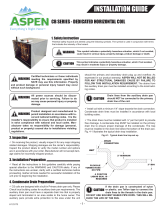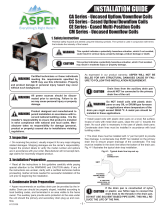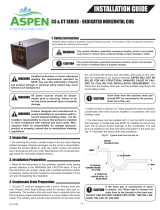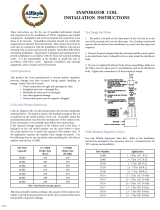ASPEN EVAPORATOR COIL INSTALLATION INSTRUCTIONS
NOTE: These instructions are for the use of qualified individuals trained and
experienced in the installation of HVAC equipment and related components. Installation
and service personnel are required by some states to be licensed. Unqualified persons
should not install this equipment nor interpret these instructions. Once installed, Aspen
coils may contain chlorofluorocarbons (CFC's) or hydrochlorofluorocarbons (HCFC's).
Under certain conditions, CFC's & HCFC's may pose a health risk. Please notify a
licensed service technician immediately if you suspect your system may contain a leak.
These instructions must be used only in conjunction with the installation of Aspen coils
and are intended only to advise and assist the installer. Read them fully before
attempting installation. This product is designed and manufactured to permit installation
in accordance with local and national building codes. It is the installer’s responsibility to
install this unit in accordance with these codes. Improper installation may damage
equipment, create a hazard, and void warranty.
CAUTION!! DO NOT USE PLASTIC DRAIN PANS ON ANY OIL OR DRUM TYPE
FURNACE. FOR THESE APPLICATIONS, A METAL PAN SHOULD BE SPECIFIED.
MAINTAIN 1-1/2’’ CLEARANCE BETWEEN PLASTIC PAN AND HEAT EXCHANGER.
Coil Preparation
• This coil was manufactured with a dry nitrogen precharge of 60 psi. Prior to
installation, release holding charge through Schrader valve test port. If no holding
charge pressure is present, return coil to the distributor for exchange.
• Clear drain holes.
• Clean coil fins with a coil degreasing agent or mild detergent.
• Rinse fins clean.
• Straighten any bent fins with a fin comb.
Coil Installation
• Coil must be installed on the discharge side of the furnace in horizontal applications.
• Supply air may enter either side of the CE cased coil.
• Install coils with plastic drain pans (CC cased upflow/downflow coils, CE cased multi-
position coils, CA uncased upflow/downflow coils and CB/CP dedicated horizontal coils)
on a level, flat surface. Install CA uncased upflow/downflow coils with metal drain pans
sloped 1/4” toward the drain. Install coils with metal drain pans AND with model
numbers beginning with the letters BV, CC, CE, CB, CP or CQ on a flat level surface.
Install coils with model numbers beginning with the letters BH, CA or CM sloped 1/4” per
foot towards the drain.
• Install condensate drain lines in accordance with local building codes.
• If the drain pan is constructed of nylon or plastic, use Teflon tape to connect the drain
line to the threaded drain on the coil.
• If a secondary drain line is required, it must be run separately from the primary drain
and should terminate in a highly visible location.
• Drain lines must be installed with a 1/4” per foot pitch to provide free drainage. A
condensate trap MUST be installed on primary line to ensure proper drainage. The trap
must be installed in the drain line below the bottom of the drain pan. The secondary
should be installed according to local codes and ordinances.
• Red drain plugs are not to be reused without plumbers tape or putty.
• In attic installations where the coil is resting on the floor, a suitable isolation pad
should be provided to minimize equipment sound transmission to ceiling below.
• When horizontal coils are installed above ceilings or in other locations where damage
from condensate overflow may occur (see CQ exception below), A SECONDARY
DRAIN PAN MUST BE PROVIDED BY THE INSTALLER AND PLACED UNDER THE
ENTIRE UNIT WITH A SEPARATE DRAIN LINE PROPERLY SLOPED AND
TERMINATED IN AN AREA VISIBLE TO OWNER. THIS SECONDARY PAN
PROVIDES EXTRA PROTECTION TO THE AREA UNDER THE UNIT SHOULD THE
PRIMARY DRAIN PLUG UP AND OVERFLOW. AS EXPRESSED IN OUR PRODUCT
WARRANTY, ASPEN WILL NOT BE BILLED FOR ANY STRUCTURAL DAMAGE DUE
TO FAILURE TO FOLLOW THIS INSTALLATION REQUIREMENT. Drain lines from an
auxiliary pan must be installed, but should not be connected to the primary drain line of
the coil. CQ has a secondary drain pan factory installed internal to the cabinet, a field
installed secondary drain pan is NOT required under the entire unit (CQ only), follow
drain line installation the same as described above.
• Special instructions for BB Series dedicated horizontal coils: Arrange secondary pan
with drain line facing desired direction for right or left hand drainage. Attach secondary
drain pan using four (4) screws directly into the side of the secondary drain pan
overlapping attachment flanges. Use one (1) screw per flange. DO NOT PUNCTURE
PRIMARY DRAIN PAN WITH SECONDARY PAN ATTACHMENT SCREWS.
• Use refrigerant line sizes recommended by the outdoor unit manufacturer.
• Some Aspen coils may include a Schrader valve on the suction manifold. During
installation, the Schrader valve must be protected from heat or it may leak.
• Braze refrigerant connections. To avoid damage to grommets (when present),
remove these prior to brazing by sliding over lines. Join refrigerant lines and allow to
cool before reinstalling grommets. Use the instructions from below which are
appropriate to the type of metering device on the coil you are installing.
Flowrator Coils:
NOTE: The Aspen flowrator can be used in both heat pump and cooling only
applications. Use piston size recommended by the outdoor unit manufacturer whenever
possible. If this information is not available, use the chart below to size the piston. If
the application requires it, the installer must change out the piston. The factory-installed
piston size is stamped on the piston body. Use this chart to replace the piston when
matching the coil with an outdoor unit with a different nominal capacity than the coil.
The piston should be sized according to the capacity of the outdoor unit. Failure to
install the proper piston can lead to poor system performance and possible compressor
damage.
• Disassemble flowrator body using two wrenches and unscrewing with a counter-
clockwise motion. Be sure to replace the white Teflon seal in place (located between
the halves). Discard Schrader if present.
• Slide attachment nut on liquid line.
• Braze the stub-out portion to the liquid line and let cool.
• Taking care that the white Teflon seal is still in place inside the flowrater body, screw
attachment nut to flowrater body.
• Tighten all connections taking care to use proper back-up. Do not overtighten the
flowrator body when reassembling. This can cause the body to warp and the piston to jam.
Piston Replacement:
• Use two wrenches to open the piston body and avoid distortion of the feeder tubes.
• Remove existing flowrator piston with the use of a small wire or pick. NOTE
ORIENTATION OF PISTON IN THE FLOWRATOR BODY. POINTED END GOES
TOWARD COIL.
• Replace the piston with one of the correct size. Do not force the new piston into the
body. Be certain the piston is installed in the correct direction. Make sure the piston
moves freely in the body before reassembling.
Field-Installed Expansion Valve Coils:
• When field-installing an expansion valve, it is not necessary to remove the access panels
and slide the coil out of the housing.
• Disassemble flowrator body using two wrenches and unscrewing with a counter-
clockwise motion. Be sure to replace the white Teflon seal in place (located between the
halves).
• Remove existing flowrator piston with the use of a small wire or pick.
• Remove the TXV from box and note the location of the inlet side (threaded male port)
and the outlet side (female swivel nut port).
• Taking care that the white Teflon seal is still in place inside the flowrator body, screw the
female swivel nut onto the flowrator body.
• Place attachment nut on liquid line.
• Braze the stub-out portion to the liquid line and let cool.
• Remove the additional white Teflon seal ring from the kit box and place on the shoulder
just inside the inlet port. Screw the nut attached to the stub-out portion of the flowrator
body onto the inlet port of the TXV
• Tighten all connections taking care to use proper back-up.
TXV Coils With a Schrader Port on the Suction Line:
• Remove valve stem from Schrader port mounted on the suction line
• Screw flare nut on TXV equalization tube into Schrader valve stem.
TXV Coils With No Schrader Port on the Suction Line:
• Locate a convenient spot on the suction line manifold and punch a 1/4' hole with a pick
or other suitable tool.
• Do not drill as chips will enter suction line manifold
• Insert TXV equalizer tube approximately 3/8” into the hole and apply solder to seal.
All TXV Coils:
• CAUTION: The sensing bulb must be protected from overheating by removing and re-
installing the bulb or covering the bulb with a wet cloth during brazing. Likewise, the TXV
body must be protected during brazing by pointing the flame away from the valve and
wrapping the valve with a wet cloth.
• Make sure the TXV valve selected is the same refrigerant type, R22 or R410a, as the
outdoor unit. TXV caps are painted either green for R22 or pink for R410a. When a color
is not present, the cap is marked “R22” or “R410a”.
• Place valve identification sticker adjacent to Aspen model number on unit nameplate.
• The valve should be sized according to the capacity of the outdoor unit. Failure to install
the proper valve can lead to poor system performance and possible compressor damage.
• Mount TXV sensing bulb using the copper clamp. In order to get a good temperature
reading and correct superheat control the sensing bulb must conform to ALL of the
following criteria: 1) placed in direct contact with the suction line, 2) mounted on a
horizontal plane of the suction line, 3) mounted at either 4 or 8 o’clock position on the
suction line circumference, and 4) insulated from outside air. This mounting location
guards your sensing bulb from false readings due to hot outside air or liquid refrigerant
formed inside the suction line.
• Coils with non-bleed expansion valves (X2, X4, X5, X, 4) may require the use of hard-
start kits. Follow the outdoor unit manufacturer’s guidelines.
Coil Installation (cont.)
• If a time delay relay is used, adjust it for the optimum delay recommended by the outdoor
unit manufacturer.
• Tape the coil cabinet for an airtight seal, and insulate the suction line.
• Downflow coils should not exceed 350 CFM/ton.
System Charging
• Bring airflow up to the maximum CFM possible without exceeding a 0.3 in. wet coil static
pressure drop across the coil.
• Flowrator coils. Add refrigerant until the superheat measured at the outdoor unit suction
line matches the superheat from the chart below.
• Expansion valve coils. Add refrigerant until the subcooling measured at the outdoor unit
liquid line matches the subcooling from the condenser manufacturer recommended
temperature (ie 7º-10º). If the condenser manufacturer does not specify a subcooling level,
refer to the chart below.





